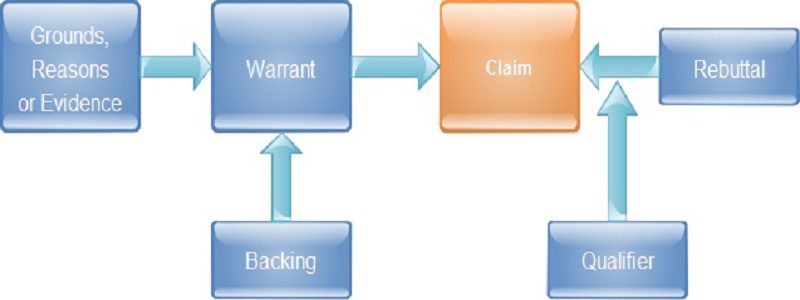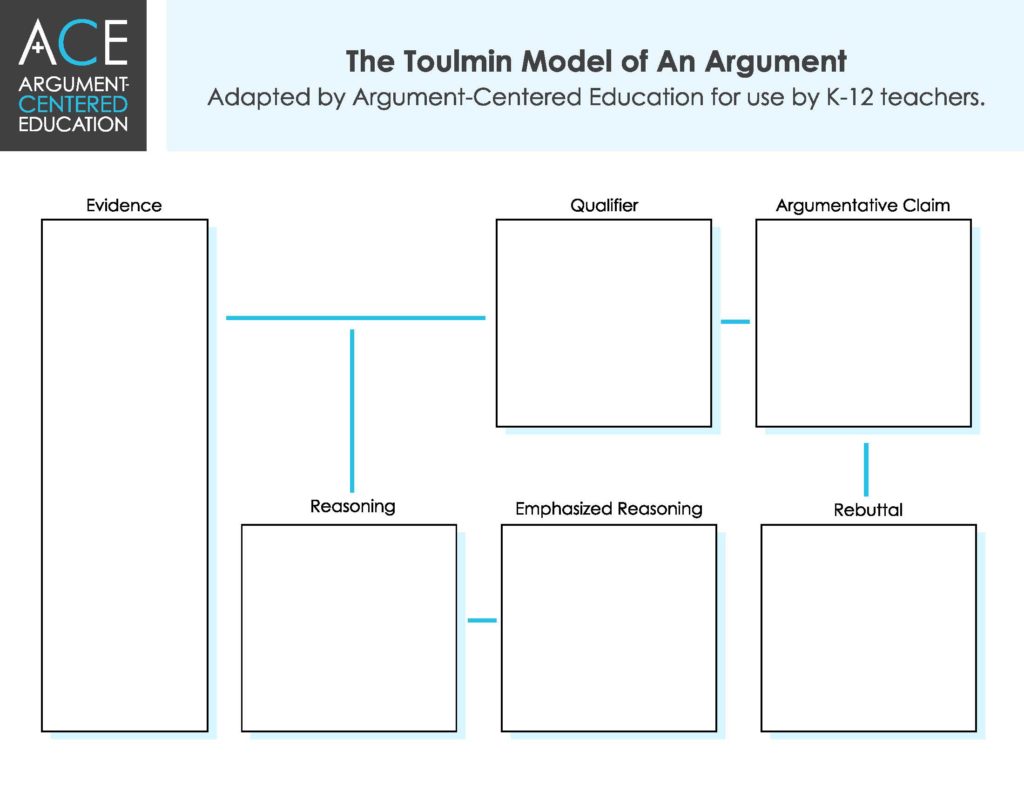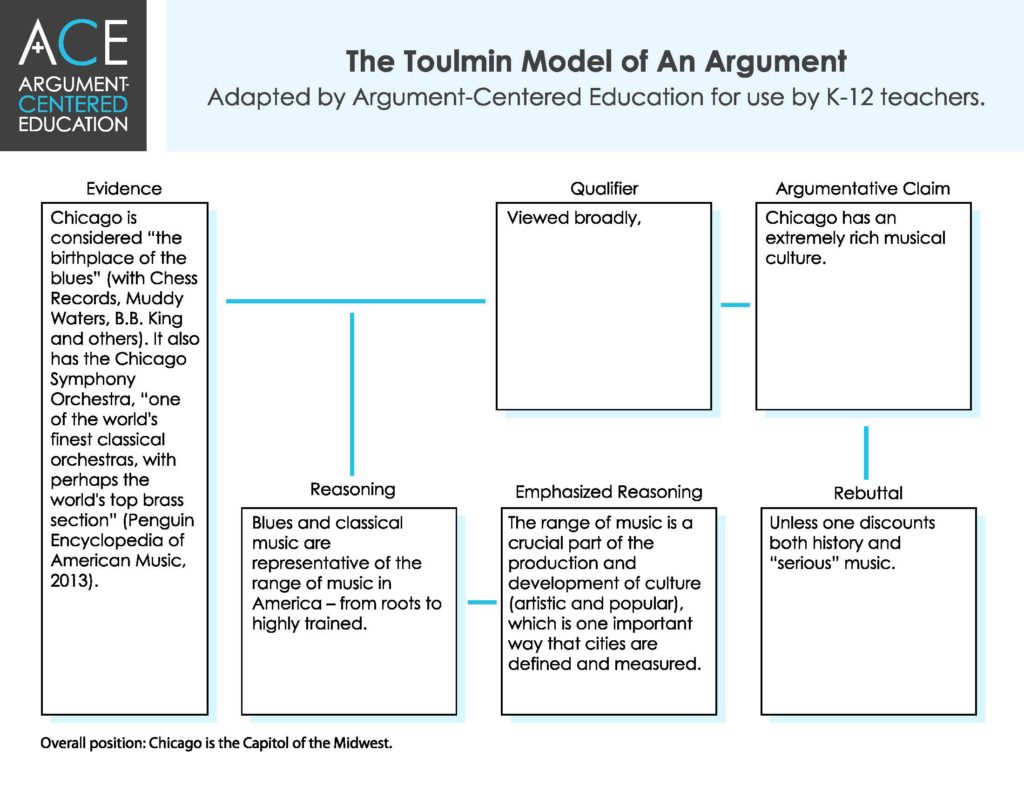
Our Adaptation of the Toulmin Model of Argument
Overview
A significant portion of all of the argumentation done in K-12 education today is rooted in the Toulmin model of argument. Every time you see claim – evidence – reasoning in the curriculum, in any of its multifarious guises, you are in the presence of a descendant of Toulmin. Few curriculum writers or teachers – and even fewer students – have a grounding in Toulmin’s argumentative theory. Because Argument-Centered Education draws on his thinking in our argument-centered resources and pedagogy we believe that it is important to dig a little deeper here.
British philosopher Stephen Toulmin created the most influential model of argument in American education, K-12 and college. Toulmin’s goal, in laying out his argument model in his 1958 book The Uses of Argument, was to raise the credibility and philosophical usability of practical argumentation, which is contra-distinguished from the theoretical argumentation of pure logic. Toulmin believed that the self-sealed, absolutist form of argument practiced by logicians in philosophy departments was too arid and esoteric, and that academia needed to pay more attention to the way that people (including teachers, writers, scientists, and critics) actually make arguments to support their interpretations, views, hypotheses, and conclusions. Toulmin wanted to know how we can build more valid and convincing arguments about practical, actual matters, rather than logical abstractions. In effect, he built a model of inductive, as opposed to deductive, argumentation.
According to Argumentation: Understanding and Shaping Arguments, by James Herrick, “Deductive arguments are arguments that lead to necessary conclusions when their reasons are true.” Their “reasons” are often called ‘premises,’ and they typically move top down, from the abstract to the particular: from a general or major premise coupled with a more specific observation (sometimes called a “minor premise”), to a conclusion which, if the premises are true, also must be true. Syllogisms are deductive arguments.
Major premise: All men are mortal.
Minor premise: Socrates is a man.
Deductive conclusion: Socrates is mortal.
The contrasting category of argument that Toulmin put on the academic map with his model is the inductive argument. Inductive arguments have reasons that lead to probable but not certain conclusions. They move from the bottom up, from the particular to the more general. According to philosopher Anthony Weston, in his A Rulebook for Arguments, “In [inductive] arguments, the conclusion unavoidably goes beyond the premises – that’s the very point of arguing by example, authority, and so on.”
The influence that Stephen Toulmin’s work has had on academia and instruction thoroughly vindicates his original view – later elaborated for academic use in An Introduction to Reasoning (1978) – that the kind of argumentation that is all around us can be made better – and can be better understood, analyzed, and evaluated – using consistently a model based on the conceptual structure he discerned.
Adapted Argument Model
Toulmin’s original terms in his argument model have in many instances been replaced by terms themselves more common and practical. The underlying meaning of the terms, and the role that they play in the conceptual structure of his model, have largely been retained. Argument-Centered Education’s adaptation of the Toulmin model of argument, which we use as a kind of default approach to argument, carries forward this practice of keeping the concepts but swapping out some of the terms.

The argumentative claim is of course the viewpoint, interpretation, hypothesis, solution, or conclusion that is being supported by the full argument. Toulmin uses the term claim in the same way, with one important difference. Toulmin – like some teachers of and writers on argument today – allow the claim to be the large, over-arching argumentative point – i.e., the thesis – where there are multiple reasons to back it up, each of which can be developed into arguments themselves. We use the term overall position to denote the larger point or thesis, and we say that each reason that supports and develops the thesis be built into an argument. Arguments, then, can be understood as evidence-based reasons for someone’s position on a question. We prefer this nomenclature because it allows us to teach a standard and undeviating rule: that every argument should have its own evidence and reasoning to support it.
Evidence is the argument’s factual, objective support for the argumentative claim. Toulmin began by calling this data, and then he shifted to the broader term grounds. Data for us is a subset of evidence; evidence is often quantitative information culled from a larger set, especially in the sciences, but it doesn’t have to be. Historical examples, analogies, quotations, examples, samples, testimonials, facts, experiences – these all apply as potential evidence for a claim. Anything that asserts to be a representation of objective reality.
Reasoning is the arguer’s own analytic explanation as to how the evidence proves the argumentative claim is true. Sometimes this is taught as the connection between the evidence and the claim. This understanding is true as far as it goes, but it doesn’t go far enough. “Connection” is more like alignment, the criterion for effective use of evidence that requires evidence to be relevant to the claim. Reasoning is the demonstration of the arguer’s thinking in their determination that this evidence is solid or extensive (if not full) proof of their claim. What makes this evidence evidence – and strong evidence at that – is another way to put it. Toulmin uses the term warrant to mean the same thing. In The Uses of Argument, he says that a warrant is a “statement that authorizes the movement from the grounds to the claim.”
Emphasized Reasoning is further development of the arguer’s effort to reveal to the reader or listener the force of the evidence as support for the claim. This can be factual backing (Toulmin’s term for this part of an argument) for the original reasoning – a kind of evidence for reasoning. Toulmin’s work contains examples of this. It can also simply be further development of the original reasoning. But it can also perform another function: to emphasize the importance of the argument as a whole, by connecting the argumentative claim to the overall position. Why is it, this version of emphasized reasoning attempts to answer, is this argument strong proof that the overall position is true?
A qualifier is a word or phrase that expresses how certain the arguer is that the argumentative claim is true. The qualifier should reflect the arguer’s own evaluation of the strength of their argument. It should be noted, though, that a qualifier is the one piece in this argument model that is not essential. Argumentative claims can be formulated in such a way to embed their own level of asserted certainty.
A rebuttal, in this context, is an acknowledgement that there is a certain condition or conditions under which the argumentative claim doesn’t hold true. It is, in effect, a conceded counter-argument. It is important to point out here that the term rebuttal is used differently in the context of argument writing (where it is used more generically, to refer to any refutation of another argument) and debating and structured argumentation activities (where it is used more narrowly as the name for a refutation-based speech or piece of writing, often one that responds to counter-arguments against the speaker or writer’s original arguments).
What follows here are two classroom-ready “models” of our adaptation of the Toulmin argument model. The text in each of the boxes can be used as examples of the corresponding constituent terms above. Note that each model has an implied overall position – the thesis or stance that the argument is advancing and developing – which is written out at the bottom of the model. We recommend that these models – or ones you build on your own – be used to teach students to use our adapted Toulmin model of argument.


Model Completion Activity
To help you teach academic argumentation using these resources, we have developed a short activity that can be used (as is) or adapted for use in any subject area. As the Directions indicate, first the above models should be presented, defined, and discussed; all students should generate one question they have about the models to propel the discussion. Next, students should be put in pairs. In pairs, they should work on completing the argument model form for each of the three issues. Note that the overall response to the issue is a position. What students are being asked to do is to create a fully developed argument to support a position: an evidence-based reason for their position. The activity should conclude with sharing out and discussing.

References
Herrick, James. Argumentation: Understanding and Shaping Arguments. Strata Publishing Co. 2011.
Toulmin, Stephen. An Introduction to Reasoning. Macmillan Press. 1979.
Toulmin, Stephen. The Uses of Argument. Cambridge University Press. 1958.
Weston, Anthony. A Rulebook for Arguments. Hackett Publishing Co. 2008.

